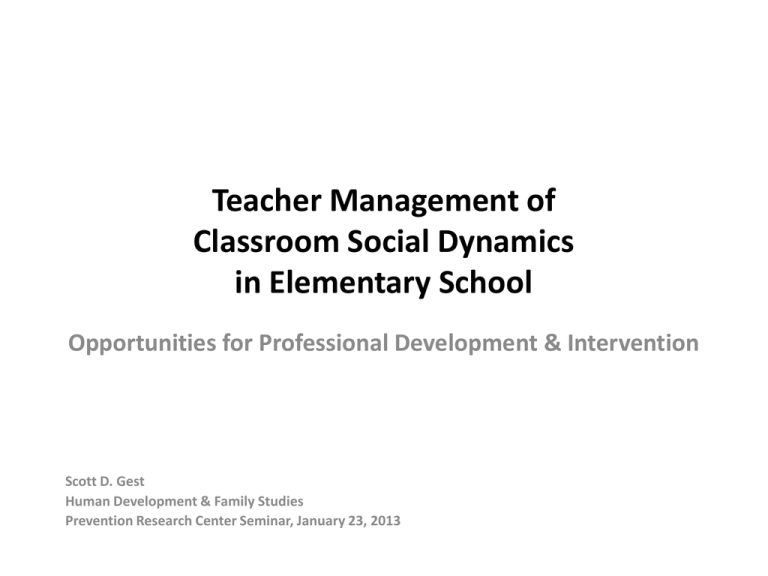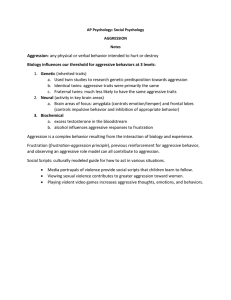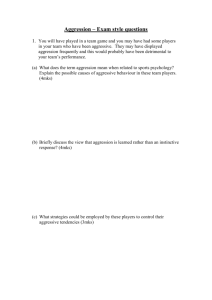Teacher Management of Classroom Social Dynamics in Elementary School
advertisement

Teacher Management of Classroom Social Dynamics in Elementary School Opportunities for Professional Development & Intervention Scott D. Gest Human Development & Family Studies Prevention Research Center Seminar, January 23, 2013 Today • • • • Classroom social dynamics & teaching Classroom Peer Ecologies Project Results from longitudinal models Teacher beliefs & implications for PD/intervention Classroom research traditions • Traditional focus on individual differences – Determinants of acceptance, rejection, popularity, friendship • Classroom context effects – Aggregated individual characteristics as a context for development • Teachers as leaders of the classroom social system – Teaching expectations of adult world (behaviors, norms) – Facilitating success within the peer system (“invisible hand”) Three salient aspects of Classroom Social Dynamics • Social status – Acceptance/rejection, popularity, influence • Affiliation patterns – Friendships and cliques • Aggression – Bullying & victimization Classroom Peer Ecologies Project • 1st, 3rd & 5th grade classrooms in PA and IL • Three assessments in a single school year • 4-year study; ~50 classrooms per year • Multiple measures at each assessment – Teacher ratings – Classroom observations – Student surveys with sociometric nominations and self-report rating scales • End of year teacher interview & ratings • Funding from W.T. Grant & Spencer Foundations & Institute of Educational Sciences Classroom Peer Ecologies Project Penn State University of Illinois PI’s Scott Gest Phil Rodkin Current Grads Rebecca Madill Handrea Logis Kathleen Zadzora Marina Serdiouk Aaron Miller David Requa Post-doc Angie Henneberger Recent Grads Deb Temkin Hae-Jeong Ahn Project Coordinators Gwen Davis Jennifer Heinhorst Data Manager Linda Jacobson Measures • Responsive Teaching – Based on CLASS observations (Pianta et al.) – Bi-factor analysis of 10 dimensions • All items permitted to load on 1st factor, capturing variance shared by all 10 items • “general” factor loadings are heavily weighted by Emotional Support items; labeled Responsive Teaching • Two additional specific factors -- Routines and Cognitive Facilitation – are not considered today Mitigating Status Extremes I try to structure the classroom environment so that social status is less relevant. I try to promote some degree of balance in social status across children in the classroom. I try to support low-status children by placing a general emphasis on the importance of social acceptance in the classroom. I try to coach low-status children to help them develop skills and strategies that could lead to a more favorable status in the classroom. I try to support low-status children by creating opportunities for them to have positive social experiences with higherstatus children. I try to create extra opportunities for lowstatus children to receive recognition. Mitigating Status Extremes: High teacher-rated use of these strategies Well what I try to do is first of all empower them…find their strengths and …have the other children listen to me tell what their strengths are. Not just reading a laundry list of ‘Oh this is what you’re good at’-- But as the weeks go on I will make note well, boy, you know, “Sammy”, I am just ‘what a fantastic piece of writing’ and what’ll happen is children sometimes they will gravitate over to see, what was “Sammy” doing? … when the teacher gives feedback to the student that helps the student but it also allows the other students to see this teacher says this child has value. when I see a child that’s very high in peer status I watch to make sure that number one they’re not misusing their peer status, number two that they’re letting others be in control sometimes, and number three that if it’s a peer status because they’re smart that they’re not in charge of the project because all the kids look to them and say ‘well you do it because you’re smart and you can do it’ so you have to watch it. … So when that happens, I try to make sure that there are others in that group that get a chance to be leader and that might mean putting this person in a different role with somebody else who actually needs a little bit of that help. Mitigating Status Extremes: Low teacher-rated use of these strategies I don’t know. That’s hard. ‘Cause … we try to talk to kids whenever they have an issue with somebody about why do you think this person is treating you that way … and some of it is them and who they are and how people perceive them but it’s hard to really without getting too personal with them I guess it’s kind of hard to really address that. You can’t say to somebody … well you’re not popular *laughs* and that’s why you know so… sometimes we’ll try to do things where you know you try to include them in things or encourage other people to include them…. I try to switch my groups around every month and I’ll notice sometimes you know it might not be somebody they’ve really talked with much but then you know suddenly they’re kind of buddies and sitting together maybe at lunch for a little bit so I don’t know try a little bit in subtle ways I guess to help them find ways to fit in I guess. Supporting Isolated/Friendless Children I try to create opportunities for isolated and friendless children to develop new friendships. I try to help isolated or friendless children to develop friendships with specific classmates. I try to support isolated of friendless children by putting general emphasis on the importance of developing new friendships in the classroom. I try to support isolated or friendless children by working with them to develop and practice social skills or strategies for forming relationships. LOW: There may have been a couple of times where a student has said “I have nobody to play with on the playground”. And I’m like you know there are sixty first graders you can’t tell me that you have asked every person. And then they usually go off and try and they find somebody. LOW: I don’t want to push it meaning I don’t want to force a student to feel like they need to play with somebody or to have somebody play with them unless they’re telling me I have no friends or I just wish people would play with me then I have no problem trying to get them in situations where hey why don’t you and you go on the carpet and just read a book together or at recess maybe I can talk to a few responsible students who I trust just would you mind incorporating this person. But unless they tell me something like that or it seems like their self esteem is really low or something I don’t try to push the natural things I feel like they’re trying to do. HIGH: That’s when I try to pull in my other groups to maybe take them into their group. Because I think as a little girl I was kind of isolated like that and nobody really stepped in so I think that’s why I’m so why it sticks out at me. ‘Cause I went through that and nobody stepped in you know so I don’t want anybody to go through that…because I was just shy. HIGH: That’s a challenging one…Because you want to think about all the reasons why that student may be unpopular and doesn’t have friends. Is it a personal choice? Is it the choice of other students around them? So I guess like getting to the bottom of it. Trying to figure out why that person has secluded themselves or are they being secluded from other students and then if that is the case you know encouraging them to find one person who they feel comfortable around to be a friend with or maybe kind of you know choosing a student who is usually pretty reasonable and friendly and encouraging that student to play with them. I mean there’s a number of ways that you can do it but you also have to be sensitive to the fact that students aren’t unintelligent they know if someone is trying to force someone on them and it’s just something that’s I find can be pretty challenging to do. Preventing Problematic Friendships I try to structure the classroom environment to prevent problematic friendships or friendship groups from forming. I try to improve the problematic social interactions that may be associated with certain friendships or friendship groups. I try to limit opportunities for problematic friendships or friendship groups to interact once they have formed. I try to encourage children involved in problematic friendships or friendship groups to develop new, less problematic friendships with other classmates. Managing Aggressive Behavior I try to structure the classroom environment to limit opportunities for aggressive, mean behavior. I deliver clear and consistent consequences for aggressive, mean behaviors in private. I try to support children who are often the target of aggressive, mean behavior by limiting their potential exposure to such behavior. I try to support children who are the target of aggressive, mean behavior by intervening right away when I see these behaviors occur. I try to coach children who are often the target of aggressive, mean behavior in how to avoid being targeted and how to respond effectively. Promoting Positive Behavior I try to influence the social interactions of children who display aggressive, mean behavior by creating positive social opportunities for them. I try to influence the social interactions of children who display aggressive, mean behavior by creating positive classroom roles for them. I try to help students who display aggressive, mean behaviors to develop alternative behaviors. I try to support children who are often the target of aggressive, mean behavior by creating extra, positive classroom roles for. I try to support children who are often the target of aggressive, mean behavior by creating positive social opportunities for them. Measures • Classroom Relationships – Teacher support • My teacher is kind to me; …treats me fairly; – Peer support • Kids in my classroom treat each other with respect;…work together to solve problems • Achievement Motivation – Striving (effort & commitment) • Doing well at school is important to me; I do the best I can at my schoolwork – Intrinsic interest (affect toward school) • I enjoy my schoolwork; I like going to school • Aggression – Peer nominations: fights; picks on others Questions • When teachers report frequent use of strategies to manage social dynamics, do students experience improvements across the school year in (a) classroom relationships, (b) achievement motivation and (c) aggressive behavior? • Do the effects of CSD strategies remain significant after accounting for a general levels of Responsive Teaching? • Are the effects of CSD strategies moderated by Responsive Teaching such that they are more effective when teachers display high levels of responsive teaching? • What do teachers’ beliefs about CSD strategies suggest about possible approaches to PD/intervention? Growth models • N = 48 classrooms • Intercept, linear growth in DV across 3 waves • Controls – Grade level – Gender composition – Class size – School (fixed effect) • CSD teaching strategy Classroom Relationships Teacher-Reported Strategy Use Growth in Teacher Support Growth in Peer Support .07* .09** Supporting Isolated Students ns .07** Managing Problem Friendships ns ns Preventing Aggression ns ns Promoting Positive Behavior ns ns Mitigating Status Extremes Classroom Relationships (controlling for Responsive Teaching) Teacher-Reported Strategy Use Growth in Teacher Support Growth in Peer Support .07* (ns) .09** (.07*) Supporting Isolated Students ns .07** (.07*) Managing Problem Friendships ns ns Preventing Aggression ns ns Promoting Positive Behavior ns ns Mitigating Status Extremes Responsive Teaching did not significantly moderate the effects of strategy use. Achievement Motivation Teacher-Reported Strategy Use Striving Intrinsic Interest Mitigating Status Extremes ns .13* (ns) Supporting Isolated Students ns ns Managing Problem Friendships ns ns Preventing Aggression ns ns Promoting Positive Behavior ns .10* (ns) Responsive Teaching * Preventing Aggression (Boys) 4.4 (1) High Responsive Teaching, High Prevent Aggression 4.35 Academic Striving 4.3 4.25 (2) High Responsive Teaching, Low Prevent Aggression 4.2 4.15 (3) Low Responsive Teaching, High Prevent Aggression 4.1 4.05 4 (4) Low Responsive Teaching, Low Prevent Aggression 3.95 3.9 1 3 Time Aggression Teacher-Reported Strategy Use Aggression Mitigating Status Extremes ns Supporting Isolated Students ns Managing Problem Friendships -.005* (-.004+) Preventing Aggression -.01** (-.01***) Promoting Positive Behavior -.01** (-.01**) Interactions with attunement & responsive teaching Tentative conclusions • Teacher-reported strategies for managing classroom social dynamics are associated with different trajectories of classroom adjustment • Some evidence of domain-specific effects – Strategies focused on status and friendships are associated with perceived peer support – Strategies focused on aggression are associated with trajectories of aggression • Most main effects of strategies are independent of the effects of generally responsive teaching • Some effects of strategies are only evident when general responsive teaching is high Teacher Attitudes about Classroom Social Dynamics Importance for teaching Mean SD 3.52 0.59 3.31 2.93 0.77 1.14 2.91 0.99 2.86 2.61 2.47 2.38 1.14 1.15 1.10 1.28 How important is it for you to play a role in this area? How much do issues related to this area affect your ability to reach your instructional objectives? How much do issues related to this area affect your ability to reach your behavior management objectives? Reasons for Non-Involvement It is better for children to work out these issues on their own. (Status & Friendship) These issues do not affect what happens in the classroom. When concerns arise, it is better to make a referral to the appropriate school support personnel. A teacher’s job is to stay focused on academic instruction. If teachers spent time on these issues they would never get any teaching done. It is not clear what a teacher could do to affect these issues. It is better for children to work out these issues on their own. (Aggression) Sources of Information about CSD Mean SD I pay close attention to students’ interactions inside the classroom (e.g., informal interactions or interactions related to classwork) 3.89 0.87 I change seating arrangements or work groups regularly to see how different children interact with each other. 3.73 0.83 I pay close attention to students’ interactions outside the classroom (e.g., in the hallways, at lunch or recess). 3.68 0.95 3.63 1.00 3.58 0.94 I have conversations with teacher colleagues. 3.56 1.01 I ask children directly about these issues. 3.31 1.04 Sources of Information Children spontaneously tell me about these issues (even when I do not ask). I have conversations with other school personnel (e.g., principal, counselor, secretary, lunchroom and playground monitors). Sources of Consultation Grade-level colleagues Building administrator Different-grade colleagues School guidance counselor Special education teacher School social worker School district resource (specialist) School psychologist Mean SD 4.57 4.24 3.76 3.42 3.24 3.15 2.78 2.74 1.04 1.06 1.15 1.50 1.35 1.78 1.37 1.23 Implications • Teachers vary in how important they consider CSD – PD/interventions may need to provide evidence of impact on student motivation and behavior • There are diverse reasons for teachers *not* to get involved in CSD – PD/interventions must recognize and address these concerns • Teachers use diverse sources of information to learn about CSD, but are unlikely to ask children directly – Identifying the strategies used by the most effective teachers may help to focus PD efforts • Teachers are most likely to consult grade-level colleagues and the building administrator with questions about how to manage CSD – Tapping into natural advice-networks (e.g., teacher ‘opinion leaders’) may enhance impact Interest in learning about classroom social dynamics: “How useful would it be to learn about X in your classroom?” Mean SD % Low % High Aggression, bullying and victimization 4.67 0.78 5.56 92.59 Student feelings about relationship to teacher 4.43 0.86 5.56 87.04 Student feelings about classroom community 4.43 0.77 3.77 90.57 Students’ enjoyment of school 4.37 0.71 1.85 90.74 Students’ achievement motivation 4.37 0.85 3.70 88.89 Animosities (who dislikes whom) 4.13 1.03 9.26 83.88 Friendships (who is friends with whom) 3.78 1.11 9.26 61.11 Social status (most/least popular/influential) 3.67 1.08 12.96 62.96 Interest in learning about classroom social dynamics: “How willing would you be to ask students about…” Mean SD % Low % High Classmates who get picked on 4.52 0.69 1.85 92.59 Classmates who hit, push, say mean things 4.48 0.75 1.85 88.89 Classmates who cooperate and help out 4.41 0.74 1.85 88.89 Friends in the class (student identifies friends) 4.24 1.01 9.26 83.33 Classmates I like most 4.19 1.03 9.26 79.63 Classmates who are good at their schoolwork 4.19 1.02 9.43 81.13 Classmates I like least 4.00 1.14 13.21 73.58 Classmates who are ‘cool’ 3.94 1.24 16.67 72.22 Implications (2) • Teachers want to know more about CSD in their classrooms – A large majority believe it would be useful to learn about social dynamics – Teachers are nearly as interested in students perceived relationships & motivation as they are in aggression – Teachers are willing to ask specific questions that would provide critical information – Teachers are least interested in friendship & status info, but a majority would still be willing to ask relevant specific questions • A tool that would facilitate teachers gathering and interpreting this information could be useful – Especially if the tool incorporated tips on how the most effective teachers manage specific dynamics







